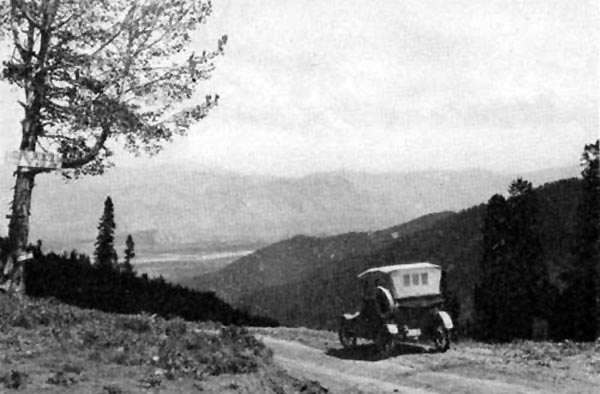
Summit Teton Pass looking east, approx. 1920.
As a practical matter motor cars did not come into the valley until about 1919.
Although Congress had passed legislation providing for funding for highways in 1916, actual implementation did not occur until
after the end of World War I. The legislation required state matchings. Provisions for state
matching in Wyoming were additionally not fully implemented until 1919. Thus actual access by motor did not occur until
about 1920.

Automobiles delayed by construction, Teton Pass approx. 1920.
As indicated by the photo, summer is road construction season.
True three intrepid motorist ventured in
prior to 1919. On July 22, 1914,
Mr. and Mrs. Ed Burton of Pocatello, Idaho, driving a Huppmobile made it over Teton Pass into the valley unassisted.
Locals, according to the
Jackson Courier, marveled that a Huppmobile was able to make the grade over Teton Pass. Earlier one car made it into
Jackson, but in the back of a wagon. In 1915, Evanston
lawyer Payson W. Spaulding made it into the valley with an automobile by way of Hoback Canyon. Transportation in or out of the Valley was by way of wagon or as noted to the
right by stage.
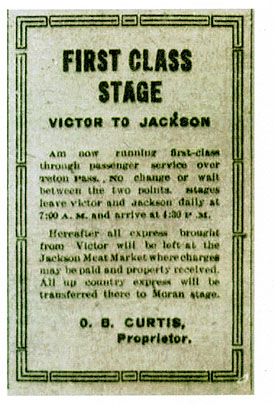
1917 advertisement for the Victor-Jackson Stage Line
As indicated by the 1917 advertisement to the right, the stage took 9 1/2 hours to go the 28 mies. The fare to Victor was $2.50. As discussed on the next page,
regular passenger stage service in the winter was problematical. The May 18, 1919 Jackson's Hole Courier noted, as an example, that
only the prior Monday was the stage and two freight teams able to cross the "hill" for the first time. The road was noted as being in bad condition.
As noted in the advertisement, a separate stage line ran northward to Moran. It too continued to run until the
1920's.
Not withstanding that the Valley and Teton Pass had been traversed by early trappers including
John Colter, John Hoback and William Sublette, as well as the 1872 Hayden Expedition, no wagons were
brought through the pass until 1885 when R. E. Miller brought one across.
As a practical matter, the only access by wagon to Jackson was by way of Idaho over the daunting Teton
Pass. Access using a motorcar was simply not tried. Although the Salt Lake Herald, July 29, 1909, reported on the hope
that an auto road would be opened that year, it apparently was not to be. An automobile made it to
Jackson Hole that year from the north through Yellowstone Park. However automobiles were not legally permitted in the
park. The park would not allow the vehicle to be towed through the park. Instead they required it to be
placed on a wagon and taken through .
Bringing in freight was an interesting proposition. Indeed, one early settler allegedly ordered a
piano from a mail order house. The piano in due course arrived via train at Victor, Idaho. It was
then discovered that the wagon with the piano could not make it up the steep grades of
Teton Pass. It was necessary to build a special cart and bring the piano in by way of an
old Indian trail.
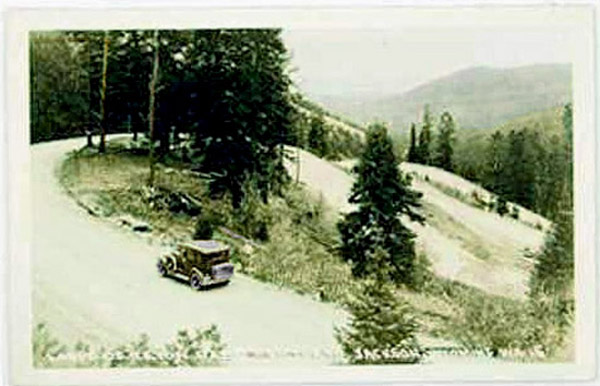
The road over Teton Pass to Victor, Idaho, 1920's
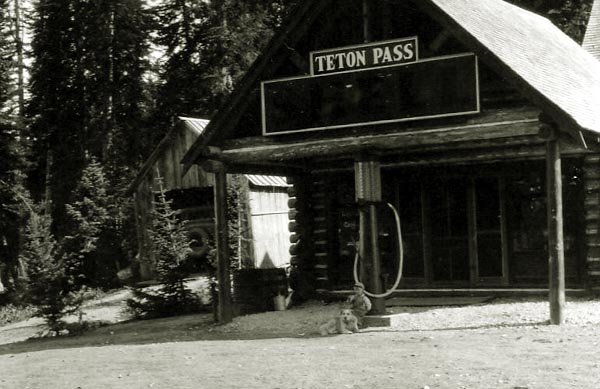
Boy and dog in front of gas pump, Teton Pass, 1920's
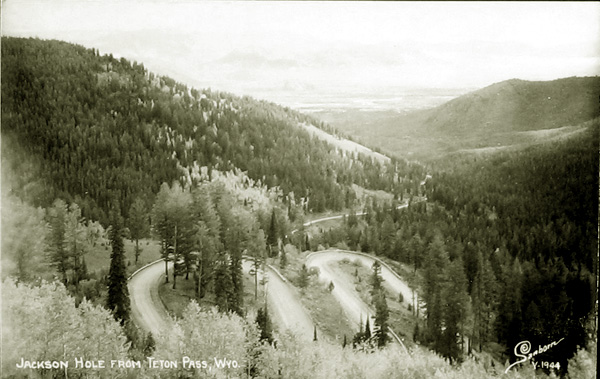
Teton Pass approx. 1940. Photo by William P. Sanborn.
The alternative to Teton Pass, would be to attempt the crossing to
Pinedale in Sublette County through Hoback Canyon and then to Kemmerer.
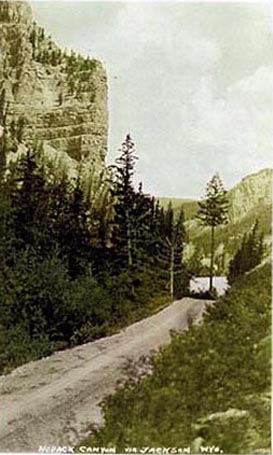 . .
. .

Left, New Road through Hoback Canyon, approx.
1922
Right, Freight wagon, Teton Pass, 1920's.
Although the Hoback Canyon had been used for access to Jackson Hole since the Hunt Party came through in 1811 guided
by John Hoback. In 1832, trappers, part of Milton Sublette's brigade, attempted to use the canyon on
their return to St. Louis from Pierre's Hole. They were attacked by Blackfeet. Two, Joseph More from Boston, apparently a
deserter from Nathaniel Wyeth's company, and a man named Foy from Mississippi were killed and their
bodies left in the Canyon. A third, Alfred K Stephens of St. Louis was wounded. He died five days later. Years later, in a
side canyon, an early forest ranger, Al Austin, found the remains of a flint lock rifle manufactured in London in 1776.
Austin was one of the early settlers in Jackson arriving about 1900. He constructed the first cabin on Bryan Flat.
Prior to 1913, the trail through Hoback Canyon was not passable by wagon. A pack train of mules was required. Indeed,
even mules had problems. In 1878, William Henry Jackson came through the canyon and one of his mules
slipped down the treacherous slope 200 feet into the river, without, however, apparent harm. The area of the canyon was not surveyed
until about 1905.
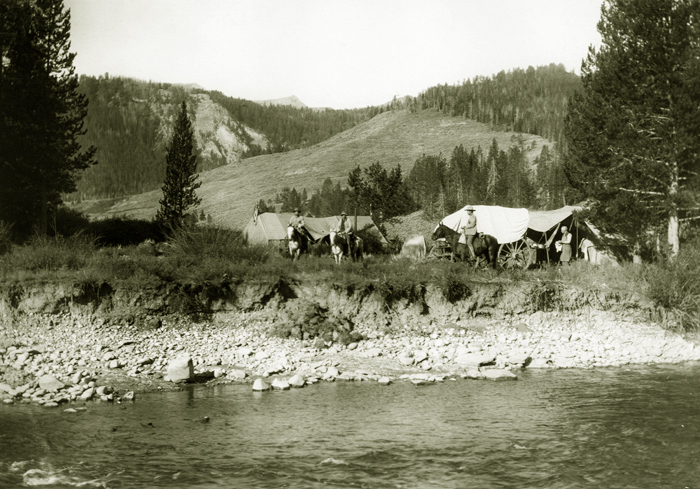
Survey Party Hoback Canyon, 1905.
In 1913, the State Engineer noted that the forestry service was expending $6,000.00 to open the
trail through the canyon for automobiles and wagons. However, in reality, the road was not ready for another
seven years. The Kemmerer Camera, August 20, 1919, after proclaiming that the best way to get to
Yellowstone by automobile was through Jackson, noted that if those crossing by way of
Teton Pass had trouple they could "get one of the construction teams engaged on road work to help them out" Care needed to be taken by those
whose vehicles were not equipped with vacuum feed as they sometimes have a difficult time making the
summit. The ferry across Snake River only cost $1.50 for a car. Readers who proposed to go by
way of Hoback Canyon were reassured that while some cars were fording the Hoback River, teams were available at
the Van Vleck ranch for a charge of $10.00 per car for pulling through five fords.
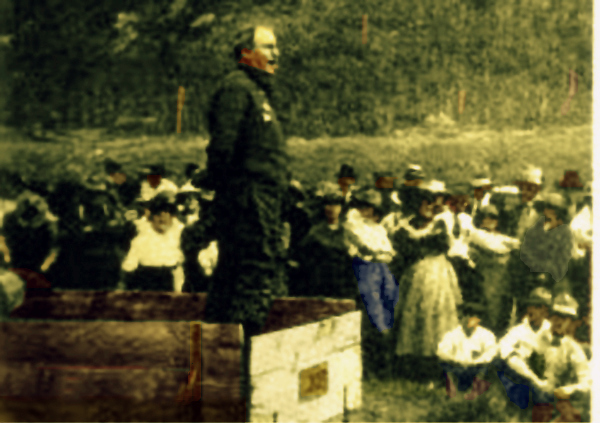
Congressman F. W. Mondell addressing crowd at opening of Hoback Canyon Road, July 13, 1922.
In 1922, the American Automobile Association noted
that the road was expected to be open by July. On July 13, 1922, the new road was dedicated by Governor Robert D.
Carey and Congressman F. W. Mondell. the opening was expected to open automobile traffic to Yellowstone from the south. The opening was
the cause of a five day day celebration, two days were spent celebrating at
Kemmer, followed by two days at Big Piney including a rodeo and finally a day at Pinedale including a baseball
game between Kemmerer and Jackson. Kemmerer won. The Mary Miles Minton Company filmed part of the opening for
its new movie "Cowboy and the Lady" in which many locals took part. Indirectly the movie ultimately led to
the construction of Bruce Porter's Teton Theater discussed on a subsequent page.
The movie was the first of a number of movies which were filmed in Jackson Hole including "Spencer's Mountain," "Shane," and "Every Which Way But Loose."
With the film however, Miss Minton, a rival of Mary Pickford in popularity, began a streak of bad luck.
While filming a scene in Jackson, she was thrown from her horse and severely injured. She managed to get
her foot loose from the stirrup. This was credited for saving her life. After filming was over,
she was in a train wreck and again injured. Before filming began, her director William Desmond Taylor was murdered.
Love letters from Miss Minton to Taylor, thirty years her senior, were found.
The crime was unsolved,
but Minton's reputation was ruined. As late as 1936 a grand jury was attempting to link her to the murder. In 1970, a major televiion network also
attempted to link her to the murder. Paramount failed to renew her contract. In the 1930's a large portion of her fortune
was embezzled by her broker.
In 1981 when she was described as a "frail old woman," she was severerly beaten in a robbery of her home.
Not withstanding the opening of the road, in the Winter Jackson remained isolated.. In the springtime,
avalanches, the "White Death" of the Rockies, would sweep down the slope and cross the road. Once the snows of
winter came, the road through Hoback Canyon would be closed until spring.

Hoback Canyon, 1930's.
Next Page: Jackson continued.